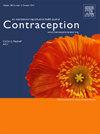Psychosocial burden of seeking medication abortion when using no-test telehealth care compared to in-person care with ultrasound
IF 2.3
2区 医学
Q1 OBSTETRICS & GYNECOLOGY
引用次数: 0
Abstract
Objectives
To explore the relationship between abortion care model and living in a state with an abortion ban with the psychosocial burden of care-seeking.
Study design
From May 2021 to March 2023, we surveyed patients obtaining medication abortion ≤70 days gestation, ages ≥15 years at four abortion clinic organizations in six U.S. states. We used negative binomial regression to assess three psychosocial burden dimensions: structural challenges (5 items, α = 0.80), lack of autonomy (3 items, α = 0.73), and others’ reactions to the pregnancy (2 items, α = 0.88) by abortion care model (no-test telehealth + mail, no-test + pickup, and in-person + ultrasound) and living in an abortion-ban state.
Results
400 people completed psychosocial burden items. In adjusted analyses, no-test telehealth + mail was associated with less overall psychosocial burden (incident rate ratio [IRR] 0.82, 95% confidence interval [CI] 0.70, 0.95), including fewer structural challenges (IRR 0.78, 95% CI 0.67, 0.91) and less lack of autonomy (IRR 0.65, 95% CI 0.47, 0.90) than in-person + ultrasound, mostly due to less difficulty traveling (24% vs 32%, p < 0.05) and feeling less forced to wait after deciding (11% vs 22%, p < 0.05). People in abortion-ban states reported more psychosocial burden (IRR 1.62, 95% CI 1.26, 2.08) including more structural challenges (IRR 1.95 0.36, 95% CI 1.53, 2.29) than people in states without bans.
Conclusions
No-test telehealth abortion care may reduce the psychosocial burden of care-seeking, especially the difficulties of travel and feeling forced to wait for care.
Implications
Findings add to the body of evidence in support of expanding telehealth abortion care by reducing travel burden and potentially increasing autonomous decision-making when seeking abortion care.
使用免测试远程保健与使用超声波进行现场保健相比,获得药物流产时的社会心理负担。
目的:探讨堕胎护理模式和生活在禁止堕胎国家是否与求诊心理社会负担有关。方法:从2021年5月至2023年3月,我们在美国6个州的4个流产诊所机构调查了妊娠< 70天,年龄0 ~ 15岁的药物流产患者。我们使用负二项回归评估心理社会负担的三个维度:结构性挑战(5项,α= 0.80);缺乏自主性(3项,α= 0.73);以及生活在禁止堕胎州的流产护理模式(无检测远程医疗+邮寄,无检测上门+上门+超声波)下的其他人对怀孕的反应(2项,α=.88)。结果:在发起调查的486人中,有400人完成了心理社会负担项目。在调整分析中,无测试远程医疗+邮件与更少的整体心理社会负担相关[发病率比(IRR) 0.82, 95%可信区间(CI) 0.70,0.95],包括更少的结构性挑战(IRR 0.78, 95% CI 0.67,0.91)和更少的自主性缺乏(IRR 0.65, 95% CI 0.47,0.90),主要是由于流产护理的旅行更容易(24%对32%,p)。无检测远程流产保健可减轻求医的心理社会负担,特别是减轻旅行的困难和被迫等待护理的感觉。含义:研究结果增加了支持通过减少旅行负担和潜在地增加寻求流产护理时的自主决策来扩大远程医疗流产护理的证据。
本文章由计算机程序翻译,如有差异,请以英文原文为准。
求助全文
约1分钟内获得全文
求助全文
来源期刊

Contraception
医学-妇产科学
CiteScore
4.70
自引率
17.20%
发文量
211
审稿时长
69 days
期刊介绍:
Contraception has an open access mirror journal Contraception: X, sharing the same aims and scope, editorial team, submission system and rigorous peer review.
The journal Contraception wishes to advance reproductive health through the rapid publication of the best and most interesting new scholarship regarding contraception and related fields such as abortion. The journal welcomes manuscripts from investigators working in the laboratory, clinical and social sciences, as well as public health and health professions education.
 求助内容:
求助内容: 应助结果提醒方式:
应助结果提醒方式:


